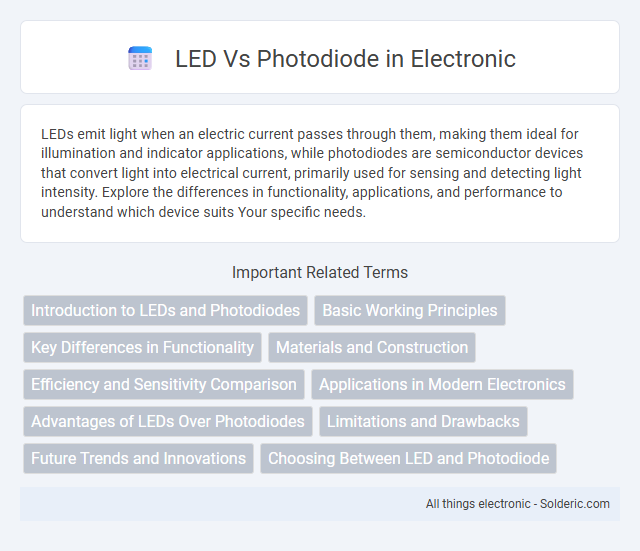LEDs emit light when an electric current passes through them, making them ideal for illumination and indicator applications, while photodiodes are semiconductor devices that convert light into electrical current, primarily used for sensing and detecting light intensity. Explore the differences in functionality, applications, and performance to understand which device suits Your specific needs.
Comparison Table
| Feature | LED (Light Emitting Diode) | Photodiode |
|---|---|---|
| Function | Emits light when electrical current passes through | Detects light and converts it into electrical current |
| Primary Use | Indicator lights, displays, illumination | Light sensing, optical communication, measurement |
| Spectral Response | Emits light at specific wavelengths (e.g., visible, infrared) | Sensitive to a range of wavelengths including visible and infrared |
| Operating Principle | Electroluminescence | Photoconductivity or photovoltaic effect |
| Typical Applications | Display screens, indicators, flashlights | Light meters, solar cells, optical sensors |
| Response Time | Fast switching (nanoseconds to microseconds) | Extremely fast response (nanoseconds) |
| Power Consumption | Consumes electrical power to emit light | Consumes minimal power, generates current from light |
| Biasing | Forward biased for light emission | Reverse biased or zero bias during operation |
Introduction to LEDs and Photodiodes
LEDs (Light Emitting Diodes) are semiconductor devices that emit light when an electric current passes through them, commonly used for displays, indicators, and lighting. Photodiodes are semiconductor sensors that convert light into electrical current, primarily utilized in light detection and optical communication systems. Understanding the fundamental operation of both devices is essential for optimizing your applications in optoelectronics and sensor technologies.
Basic Working Principles
LEDs emit light through electroluminescence, where electric current passes through a semiconductor material causing it to release photons. Photodiodes operate by converting incident light into an electrical current via the photoelectric effect within a semiconductor junction. Understanding these basic working principles helps you select the right component for applications involving light emission or detection.
Key Differences in Functionality
LEDs emit light by converting electrical energy into photons through electroluminescence, primarily used for illumination and display purposes. Photodiodes function as light sensors, generating an electrical current proportional to the light intensity they detect, making them essential in optical communication and measurement systems. Understanding these key differences in functionality helps you select the right component for applications requiring either light emission or light detection.
Materials and Construction
LEDs are primarily constructed from semiconductor materials such as gallium arsenide (GaAs) or gallium phosphide (GaP), which emit light when an electric current passes through. Photodiodes are made from silicon or indium gallium arsenide (InGaAs) semiconductors designed to convert light into electrical signals. The structural design of LEDs includes p-n junctions tailored for light emission, while photodiodes feature optimized depletion regions to enhance photodetection sensitivity.
Efficiency and Sensitivity Comparison
LEDs exhibit higher efficiency in light emission due to their ability to convert electrical energy into light with minimal thermal losses, making them ideal for illumination and indicators. Photodiodes demonstrate superior sensitivity by efficiently detecting low-intensity light signals through rapid photoelectric conversion, essential for precise optical sensing and communication applications. The efficiency of LEDs is typically measured in lumens per watt, while photodiode sensitivity is quantified by responsivity in amperes per watt, highlighting their complementary roles in optoelectronics.
Applications in Modern Electronics
LEDs serve as efficient light sources in display technology, optical communication, and infrared remote controls, leveraging their ability to emit light when electrically biased. Photodiodes function primarily as light sensors in applications like optical fiber communication, medical imaging devices, and environmental sensing, converting light into electrical current with high sensitivity. Their complementary roles enable advancements in automation, data transmission, and wearable technology, where precise light emission and detection are critical.
Advantages of LEDs Over Photodiodes
LEDs offer significant advantages over photodiodes, including higher light emission efficiency and greater durability due to their solid-state construction. Their ability to produce visible light with low power consumption makes them ideal for display and indicator applications. Your projects benefit from LEDs' longer operational lifespan and faster switching speeds compared to photodiodes.
Limitations and Drawbacks
LEDs suffer from limited spectral specificity and slower response times compared to photodiodes, restricting their use in high-speed optical detection. Photodiodes have higher sensitivity and faster response but can be more expensive and require complex signal processing circuitry. Both devices face challenges in ambient light interference and temperature dependence, impacting performance consistency.
Future Trends and Innovations
Future trends in LED and photodiode technologies emphasize increased efficiency and integration with IoT devices for advanced sensing applications. Innovations in micro-LED displays and quantum dot-enhanced photodiodes aim to improve brightness and spectral sensitivity, respectively. Research into flexible, wearable photodiodes and energy-efficient LEDs promises enhanced performance in healthcare monitoring and communication systems.
Choosing Between LED and Photodiode
Choosing between an LED and a photodiode depends on the application requirements; LEDs are ideal for light emission and indication due to their energy efficiency and varied color options. Photodiodes excel in light detection with high sensitivity and fast response times, making them suitable for optical communication and sensing systems. Understanding the specific needs for light output or detection ensures optimal performance and device longevity in electronic designs.
LED vs photodiode Infographic

 solderic.com
solderic.com